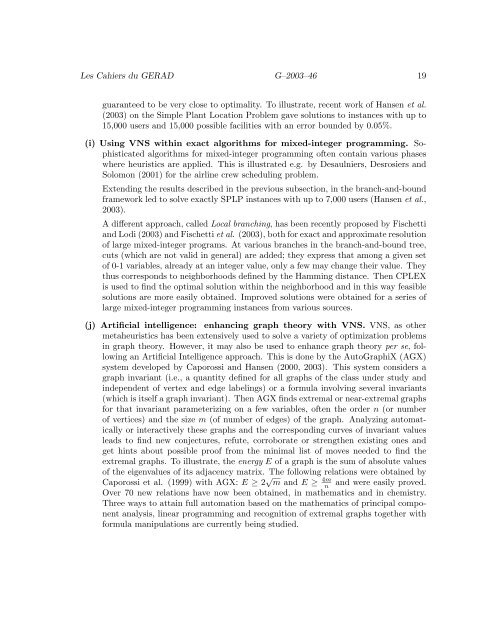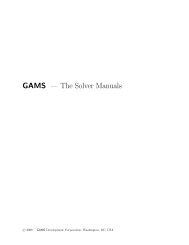A Tutorial on Variable Neighborhood Search
A Tutorial on Variable Neighborhood Search
A Tutorial on Variable Neighborhood Search
You also want an ePaper? Increase the reach of your titles
YUMPU automatically turns print PDFs into web optimized ePapers that Google loves.
Les Cahiers du GERAD G–2003–46 19<br />
guaranteed to be very close to optimality. To illustrate, recent work of Hansen et al.<br />
(2003) <strong>on</strong> the Simple Plant Locati<strong>on</strong> Problem gave soluti<strong>on</strong>s to instances with up to<br />
15,000 users and 15,000 possible facilities with an error bounded by 0.05%.<br />
(i) Using VNS within exact algorithms for mixed-integer programming. Sophisticated<br />
algorithms for mixed-integer programming often c<strong>on</strong>tain various phases<br />
where heuristics are applied. This is illustrated e.g. by Desaulniers, Desrosiers and<br />
Solom<strong>on</strong> (2001) for the airline crew scheduling problem.<br />
Extending the results described in the previous subsecti<strong>on</strong>, in the branch-and-bound<br />
framework led to solve exactly SPLP instances with up to 7,000 users (Hansen et al.,<br />
2003).<br />
A different approach, called Local branching, has been recently proposed by Fischetti<br />
and Lodi (2003) and Fischetti et al. (2003), both for exact and approximate resoluti<strong>on</strong><br />
of large mixed-integer programs. At various branches in the branch-and-bound tree,<br />
cuts (which are not valid in general) are added; they express that am<strong>on</strong>g a given set<br />
of 0-1 variables, already at an integer value, <strong>on</strong>ly a few may change their value. They<br />
thus corresp<strong>on</strong>ds to neighborhoods defined by the Hamming distance. Then CPLEX<br />
is used to find the optimal soluti<strong>on</strong> within the neighborhood and in this way feasible<br />
soluti<strong>on</strong>s are more easily obtained. Improved soluti<strong>on</strong>s were obtained for a series of<br />
large mixed-integer programming instances from various sources.<br />
(j) Artificial intelligence: enhancing graph theory with VNS. VNS, as other<br />
metaheuristics has been extensively used to solve a variety of optimizati<strong>on</strong> problems<br />
in graph theory. However, it may also be used to enhance graph theory per se, following<br />
an Artificial Intelligence approach. This is d<strong>on</strong>e by the AutoGraphiX (AGX)<br />
system developed by Caporossi and Hansen (2000, 2003). This system c<strong>on</strong>siders a<br />
graph invariant (i.e., a quantity defined for all graphs of the class under study and<br />
independent of vertex and edge labelings) or a formula involving several invariants<br />
(which is itself a graph invariant). Then AGX finds extremal or near-extremal graphs<br />
for that invariant parameterizing <strong>on</strong> a few variables, often the order n (or number<br />
of vertices) and the size m (of number of edges) of the graph. Analyzing automatically<br />
or interactively these graphs and the corresp<strong>on</strong>ding curves of invariant values<br />
leads to find new c<strong>on</strong>jectures, refute, corroborate or strengthen existing <strong>on</strong>es and<br />
get hints about possible proof from the minimal list of moves needed to find the<br />
extremal graphs. To illustrate, the energy E of a graph is the sum of absolute values<br />
of the eigenvalues of its adjacency matrix. The following relati<strong>on</strong>s were obtained by<br />
Caporossi et al. (1999) with AGX: E ≥ 2 √ m and E ≥ 4m n<br />
and were easily proved.<br />
Over 70 new relati<strong>on</strong>s have now been obtained, in mathematics and in chemistry.<br />
Three ways to attain full automati<strong>on</strong> based <strong>on</strong> the mathematics of principal comp<strong>on</strong>ent<br />
analysis, linear programming and recogniti<strong>on</strong> of extremal graphs together with<br />
formula manipulati<strong>on</strong>s are currently being studied.
















